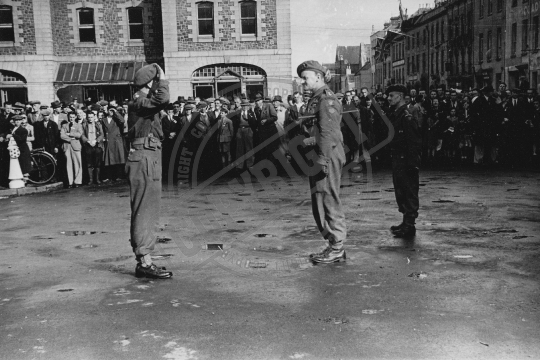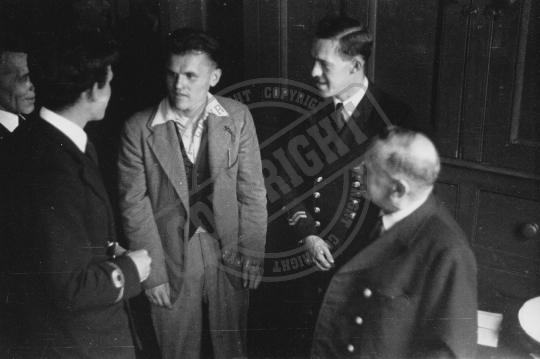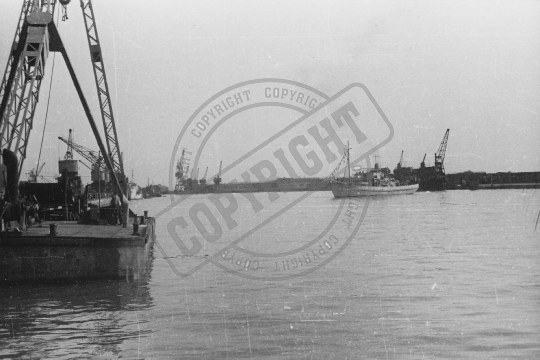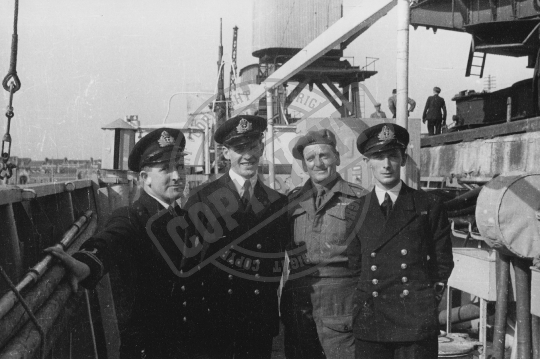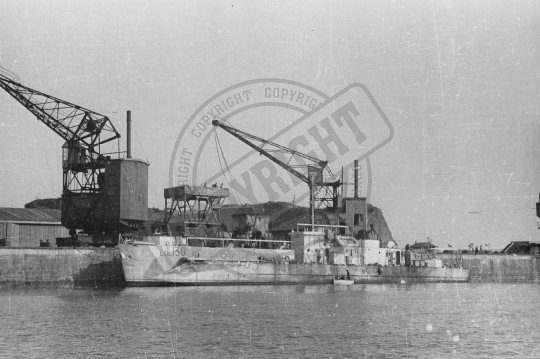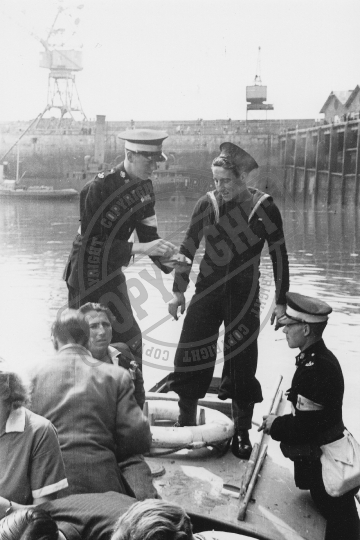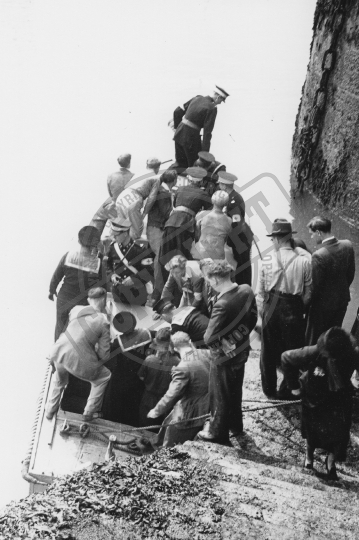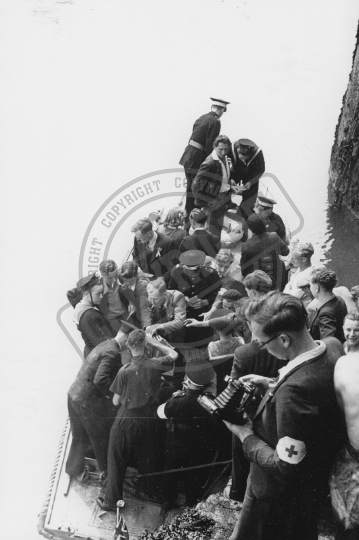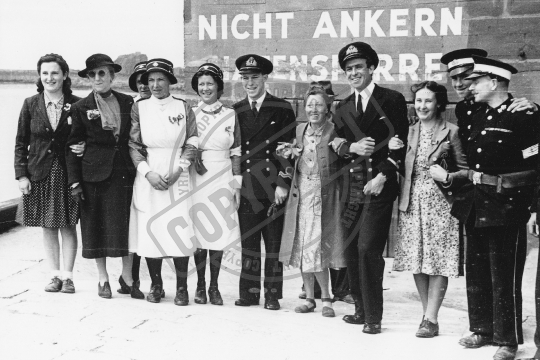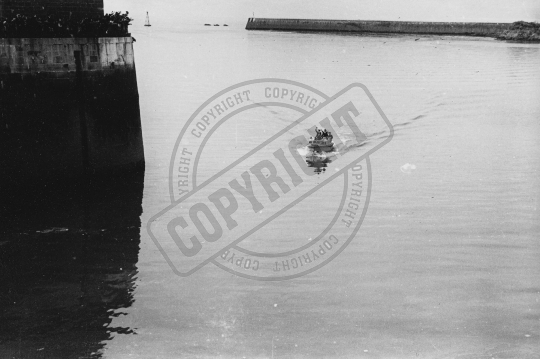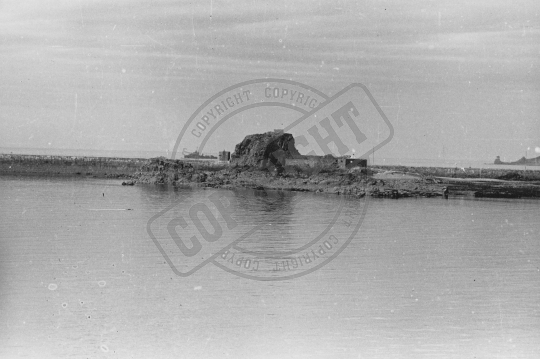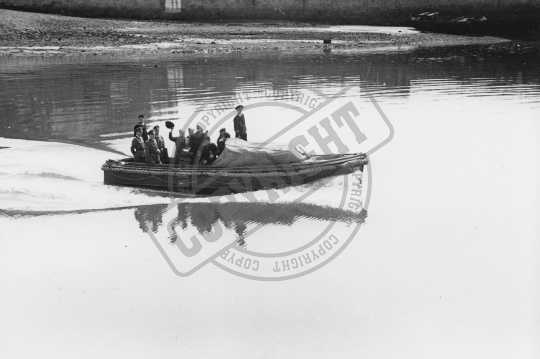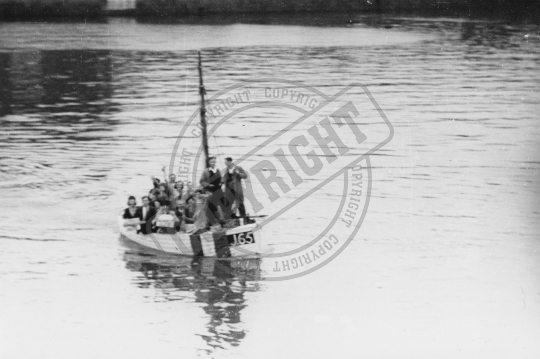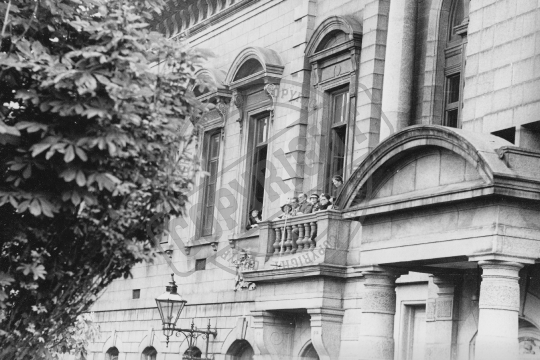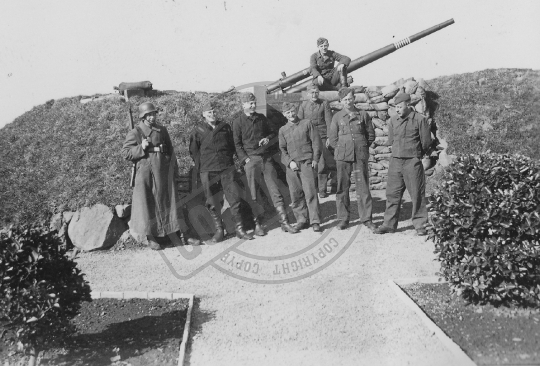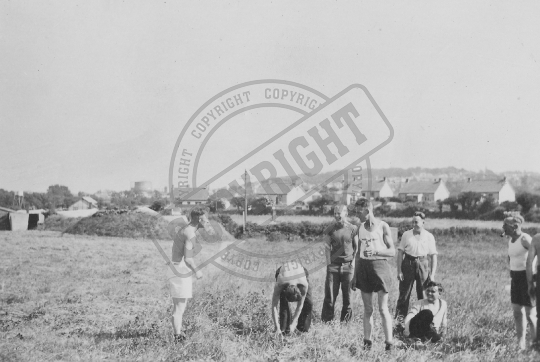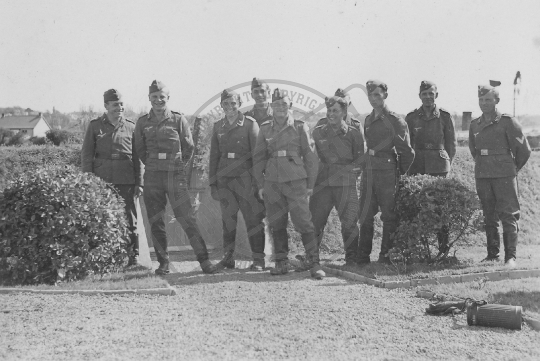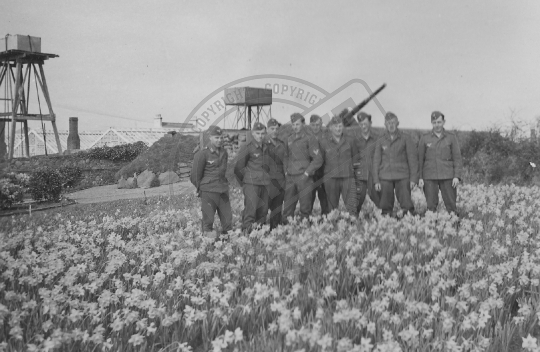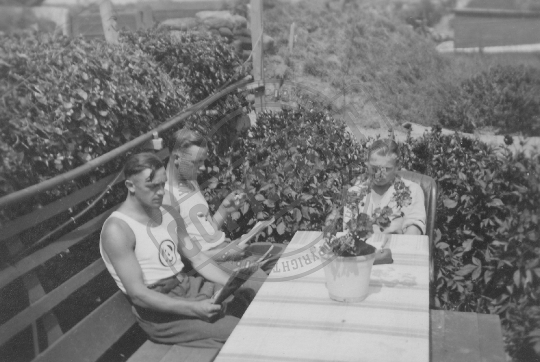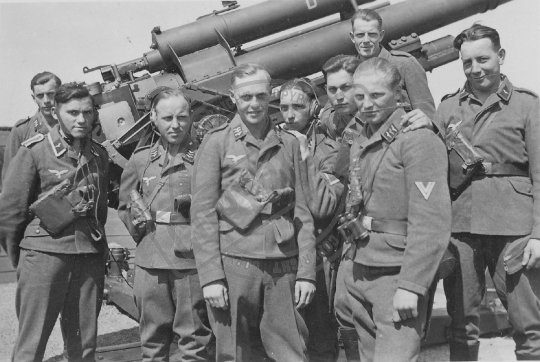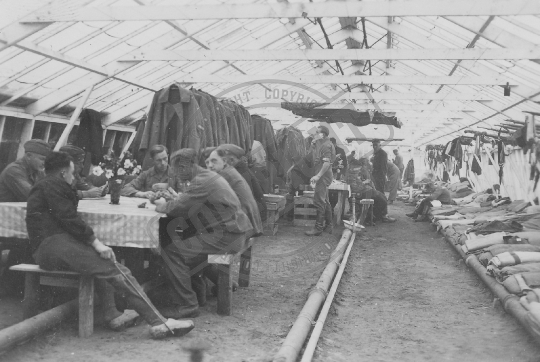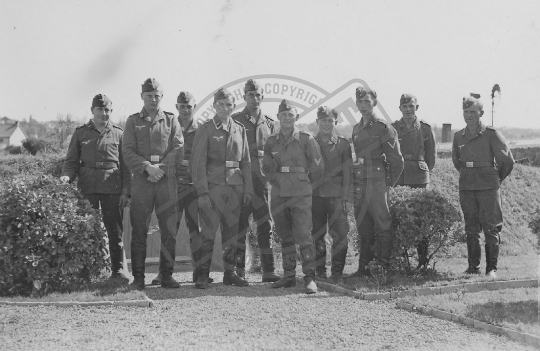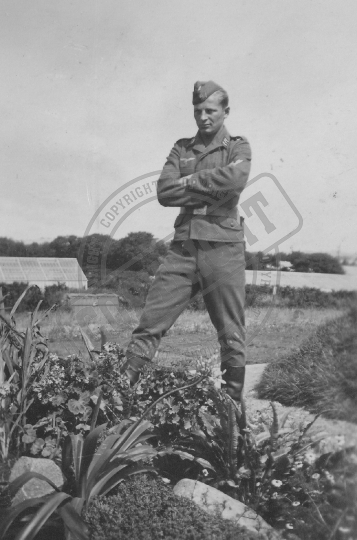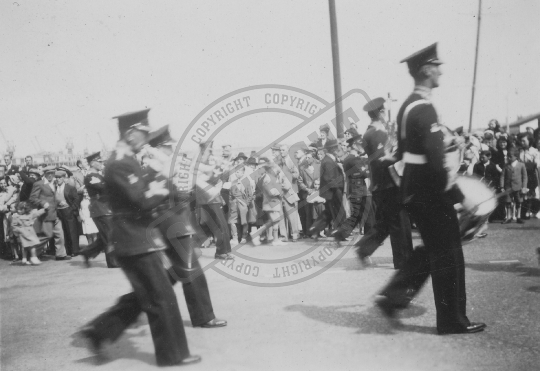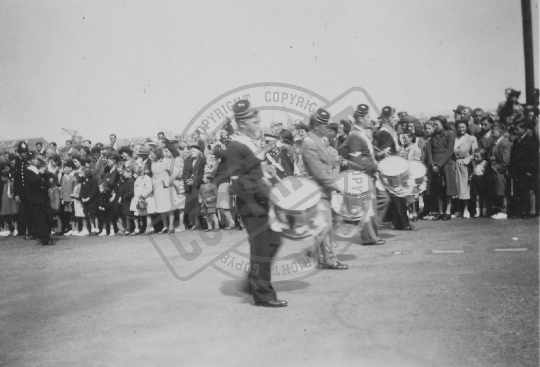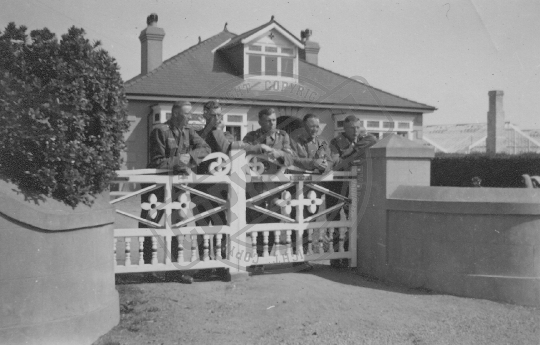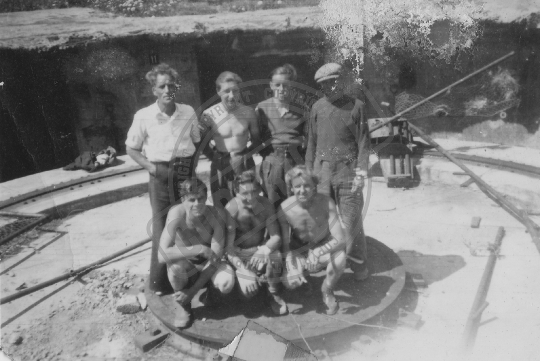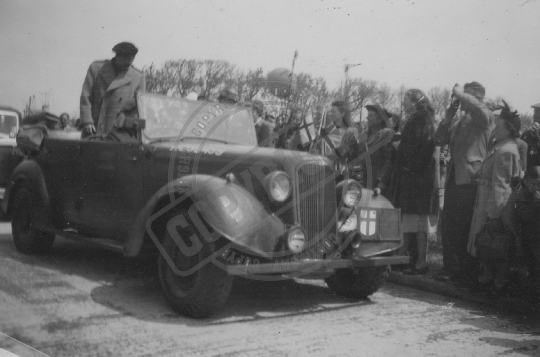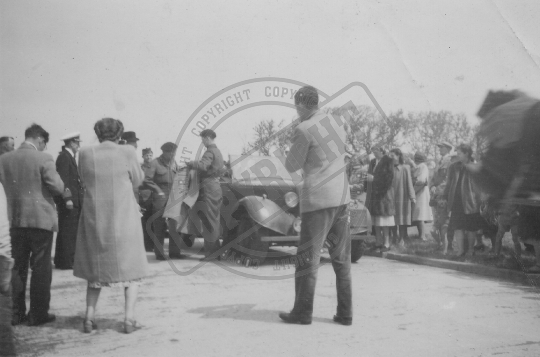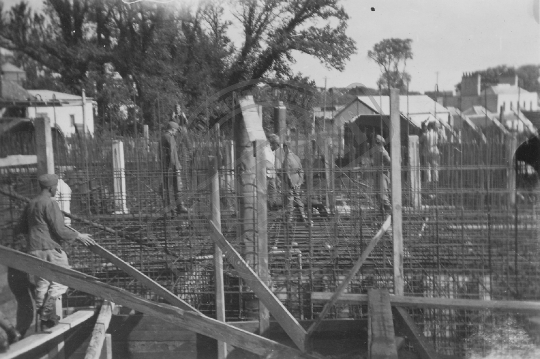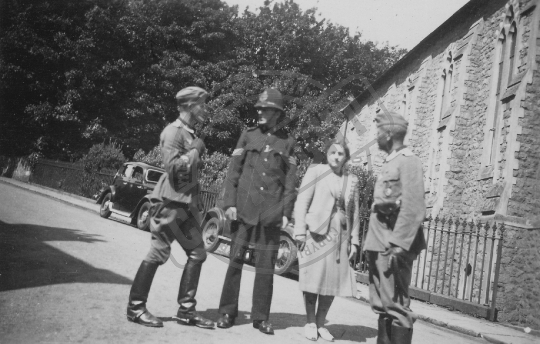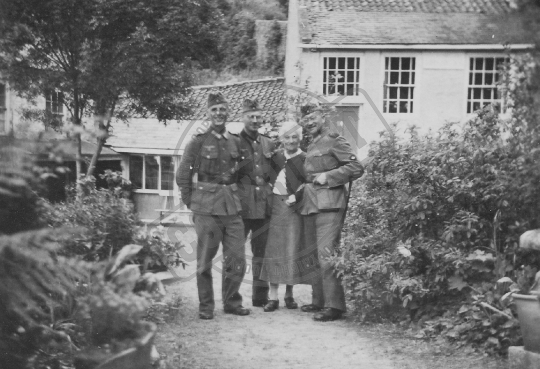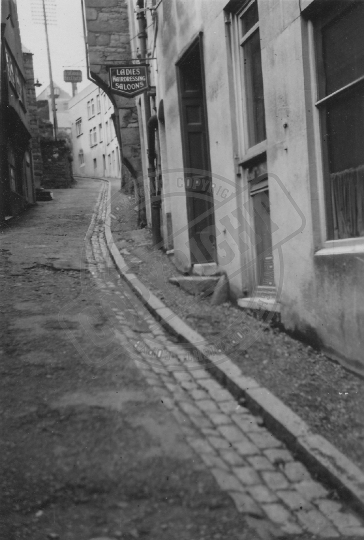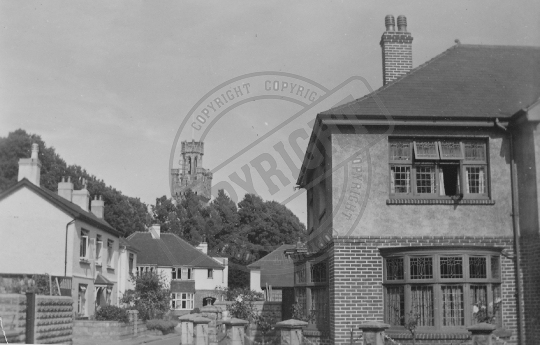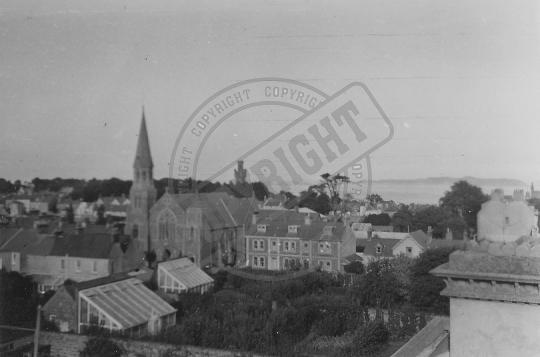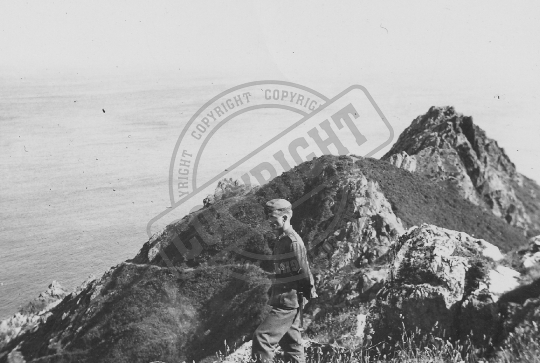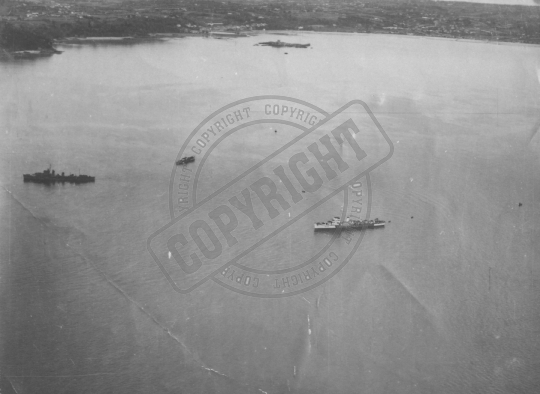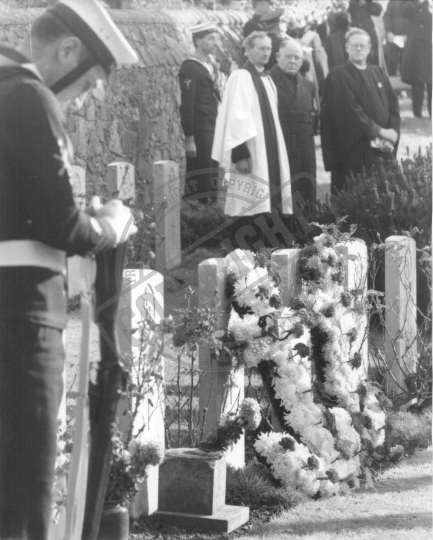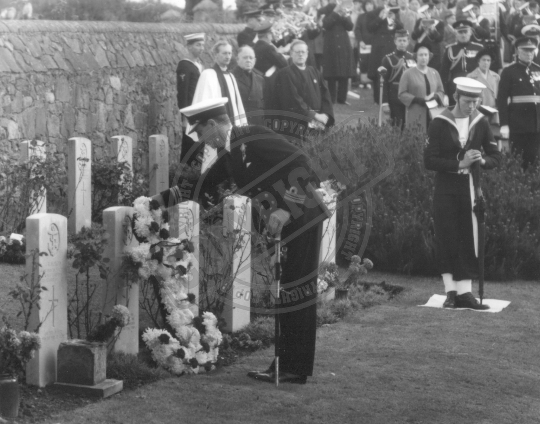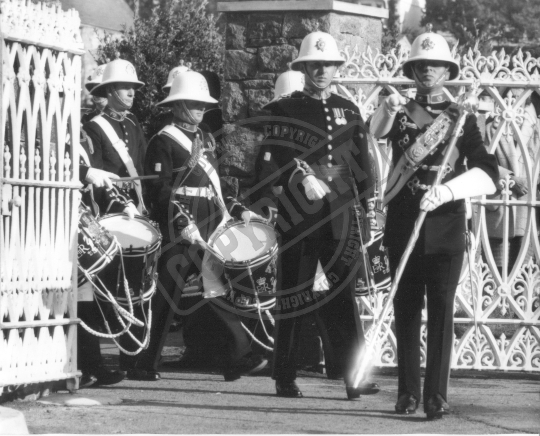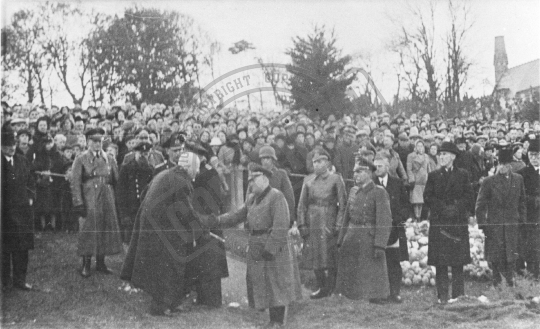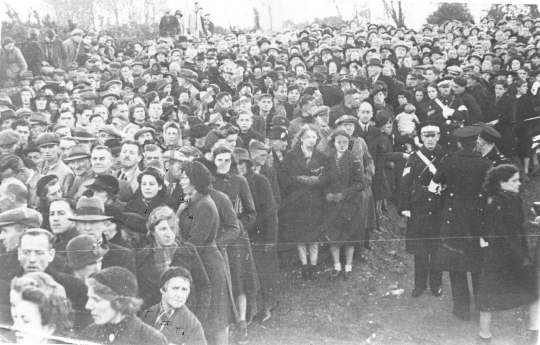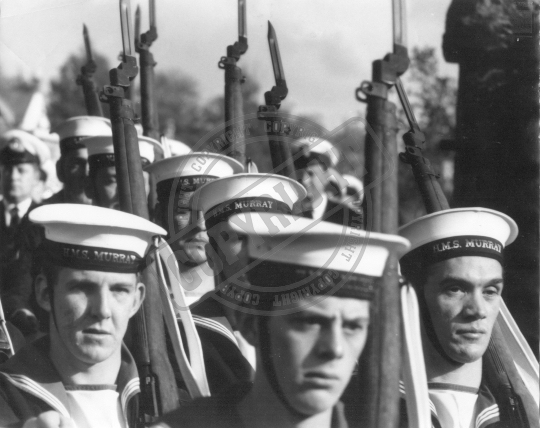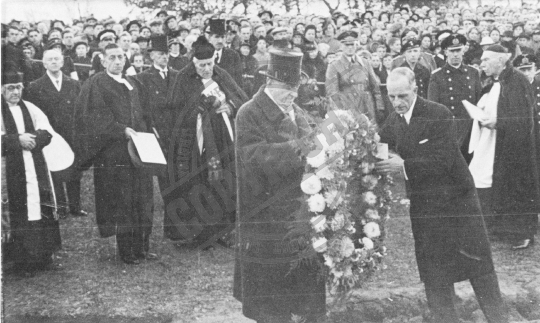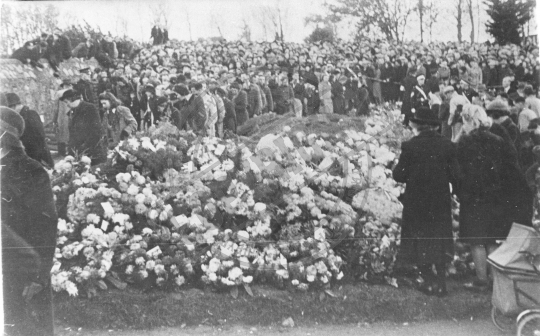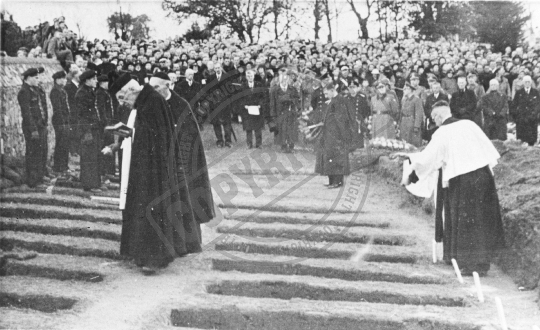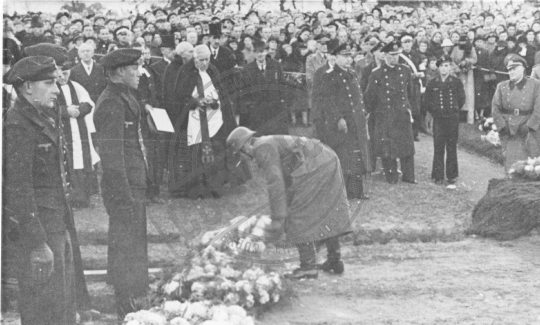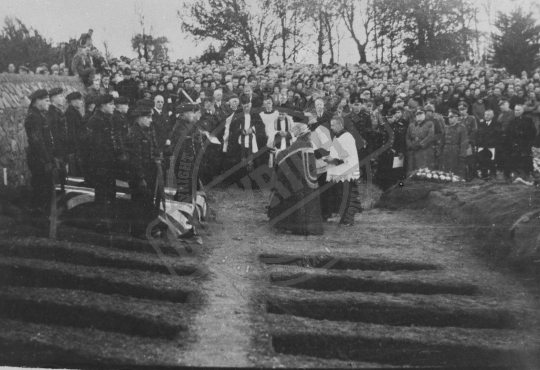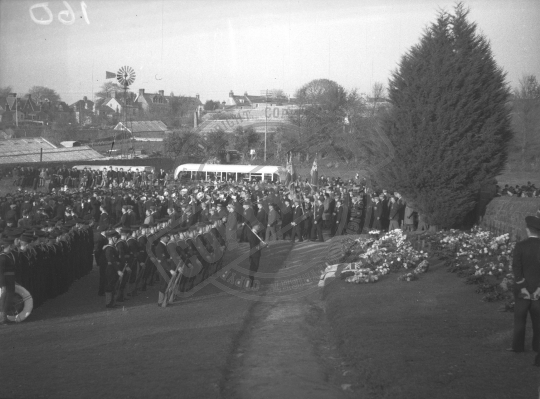Results (284)
CIMM_0065
Jersey Thursday 10th May 1945. The Guard of Honour is handed over to Lt-Colonel W. P. A. Robinson, MC, RA, the Island Commander, Jersey and Commanding Officer 620 Regiment, Royal Artillery. Captain Hugh Le Brocq is on the right.
CIMM_0061
Jersey Liberation Wednesday 9th May 1945. After unfurling the Union Jack the two RN officers chat with a Russian worker (centre), Deputy Harbourmaster Bill Furzer (left) and Harbourmaster Captain Harry Richmond (right).
CIMM_0057
Jersey Liberation Wednesday 9th May 1945. The HM Motor Minesweeper FY PT 250, commanded by Lt. Leslie Jackson, RNVR, of the 142nd Minesweeping Flotilla manoeuvring in St Helier Harbour.
CIMM_0054
Jersey Liberation Wednesday 9th May 1945. Officers of LCI(L) 130 with a Royal Engineer Major (third left) from the 'Omelette’ Advance Party. L to R; First Lieutenant (name unknown), RNVR; Sub.Lt. Jimmy Cooper, RNVR; and Commanding Officer, Lt Charles Sanders, RNVR.
CIMM_0053
The LCI(L) 130 moored alongside the New North Quay, St. Helier Harbour, Jersey. Almost immediately the main 'Omelette’ advance party of some 200 men began to land at 5pm on Wednesday 9th May.
CIMM_0049
The launch from HMS Beagle was swamped with autograph hunters at the end of the Albert Pier, Jersey.
CIMM_0048
The launch from HMS Beagle was swamped with autograph hunters at the end of the Albert Pier, Jersey.
CIMM_0046
The launch from HMS Beagle was swamped with autograph hunters at the end of the Albert Pier, Jersey. The sailor's supply of cigarettes rapidly diminished.
CIMM_0044
Everyone on the Albert Pier in Jersey wanted their photograph taken with the first Liberators ashore. L to R: Miss Betty Richomme, Miss Haines, St John Ambulance Nurses back row unknown, Mary Martret, Margaret Sewell, Surgeon-Lieutenant Ronald McDonald, Miss Frazer, Sub-Lieutenant David Milln, unknown, Maurice Gautier and Major V. Cooke.
CIMM_0043
As the craft carrying the German Island Commander and the Bailiff of Jersey reached the head of Elizabeth Castle breakwater it was passed by the launch from HMS Beagle inward bound. As the launch passed through the pierheads the crowd could see that the men on board were wearing Royal Navy uniforms, and they let out loud cheers of welcome.
CIMM_0042
View looking across St. Aubin’s bay, Jersey from St. Helier Harbour. HMS Beagle can be seen at anchor behind Elizabeth Castle breakwater. One of the two square bunkers housing the firing points for the electrically detonated mines laid in the approaches to the harbour can be seen at the root of the castle breakwater.
CIMM_0041
Jersey Bailiff’s pinnace on its way to HMS Beagle anchored in St. Aubin’s Bay, off St. Helier. The Bailiff and the Solicitor General waved their hats repeatedly in acknowledgement as the pinnace headed out of the Harbour, whilst Generalmajor Wulf and his two staff officers stood silently in the stern of the vessel.
CIMM_0040
One of the small boats that had made the trip to HMS Beagle anchored in St Aubin’s Bay, Jersey. On returning to St Helier Harbour two on board are holding up copies of the previous day’s newspapers announcing VE-Day, thrown to them by sailors on board the destroyer.
CIMM_0037
Tuesday 8th May 1945, the Jersey Bailiff, Alexander Coutanche, had a microphone erected on the balcony of the Royal Court witness room, facing the Royal Square. After the Prime Minister’s speech he spoke from the balcony to the crowd.
SP_0048.jpg
The gun crew of Flak Batterie Kapellendorf located off Les Grandes Capelles in St Sampson. This battery of four 8.8cm Flak 18 guns which were used in an anti-aircraft role. This sequence of photographs were taken in December 1941. Note the kill markings on the gun barrel.
SP_0047.jpg
The gun crew of Flak Batterie Kapellendorf located off Les Grandes Capelles in St Sampson. This battery of four 8.8cm Flak 18 guns which were used in an anti-aircraft role. This sequence of photographs were taken in December 1941. Note the gas holders located at Le Bouet in the background.
SP_0045.jpg
The gun crew of Flak Batterie Kapellendorf located off Les Grandes Capelles in St Sampson. This battery of four 8.8cm Flak 18 guns which were used in an anti-aircraft role. This sequence of photographs were taken in December 1941.
SP_0039.jpg
The gun crew of Flak Batterie Kapellendorf located off Les Grandes Capelles in St Sampson. This battery of four 8.8cm Flak 18 guns which were used in an anti-aircraft role. This sequence of photographs were taken in December 1941.
SP_0038.jpg
The gun crew of Flak Batterie Kapellendorf located off Les Grandes Capelles in St Sampson. This battery of four 8.8cm Flak 18 guns which were used in an anti-aircraft role. This sequence of photographs were taken in December 1941. Note the Luftwaffe insignia on the PT shirts.
SP_0037.jpg
The gun crew of Flak Batterie Kapellendorf located off Les Grandes Capelles in St Sampson. This battery of four 8.8cm Flak 18 guns which were used in an anti-aircraft role. This sequence of photographs were taken in December 1941.
SP_0035.jpg
The gun crews of Flak Batterie Kapellendorf seen here inside a greenhouse which appears to also be the crews accommodation and rest area. Note the beds on the right and the uniforms hanging up to the left.
SP_0033.jpg
The gun crew of Flak Batterie Kapellendorf located off Les Grandes Capelles in St Sampson. This battery of four 8.8cm Flak 18 guns which were used in an anti-aircraft role. This sequence of photographs were taken in December 1941.
SP_0031.jpg
Flak Batterie Kapellendorf located off Les Grandes Capelles in St Sampson. This battery of four 8.8cm Flak 18 guns which were used in an anti-aircraft role. This sequence of photographs were taken in December 1941.
MT_0009
Big crowds gather on Liberation Day on May 9th 1946 to watch the procession in St Peter Port.
MT_0007
Big crowds gather on Liberation Day on May 9th 1946 to watch the procession in St Peter Port.
MT_0001
German army personnel relaxing outside a requisitioned property called The Croft in Les Canus, St Sampson formerly owned by Mrs Ruaux who was evacuated in 1940. This is a typical example of troops being billeted in local properties.
MT_0004
Victor Gontier a former internee at Laufen, seen here circa 1948 with a team from Gilroy’s which were engaged in backfilling trenches and salvaging scrap at Batterie Dollmann, Pleinmont.
MT_0006
Two years after Liberation on 23rd May 1947 Guernsey had a special visit from Field Marshall Bernard Montgomery (Monty). During his visit he met with many dignitaries including those from Elizabeth College, St John Ambulance, Sea Scouts and many others. His tour was welcomed by all with the streets of Guernsey lined with locals wanting to catch a glimpse of Monty. His famous vehicle known as Old Faithful carried him around the island and included a stop at the grounds of Beau Sejour.
MT_0005
Two years after Liberation on 23rd May 1947 Guernsey had a special visit from Field Marshall Bernard Montgomery (Monty). During his visit he met with many dignitaries including those from Elizabeth College, St John Ambulance, Sea Scouts and many others. His tour was welcomed by all with the streets of Guernsey lined with locals wanting to catch a glimpse of Monty. His famous vehicle known as Old Faithful carried him around the island and included a stop at the grounds of Beau Sejour.
OA_105
Shuttering and huge quantities of steel reinforcing surround construction workers as they prepare one of the many fortifications prior to concrete being poured in the grounds of Fort George.
OA_104
A local police sergeant and civilian photographed with German soldiers outside the old Police Station located opposite St Pauls Church. The church was subsequently demolished and is now the site of the Sunken Garden.
OA_103
German soldiers with a local resident at entrance to the former Moulin Huet Watermill, one of the properties alongside the road leading down to Moulin Huet Bay.
OA_100
A view from the foot of Bertholet Street looking up the steeply graded hill that emerges onto New Street.
OA_099
With Victoria Tower in the background a view of properties in Town taken by the entrance to The Close by Doyle Road.
OA_097
Taken from the roof of a house near the junction of Les Gravees and Queens Road looking towards the spire of St Jospephs Methodist Church and Victoria Tower in the far distance.
OA_093
A German soldier stands on the coastal footpath leading to Pointe De La Moye looking east towards Les Sommeilleuses.
OA_091
Taken at Route de Cobo near Bouverie Lane looking towards Cobo Coast Road note, the white lines painted on the sea wall to aid drivers during the night in blackout conditions.
SP_0028
Off St Aubin’s Bay, Jersey on Wednesday afternoon, 9th May, 1945. HMS Cosby (Frigate) K 559, LCI(L) 130 carrying the Force 135 'Omelette advance party’, and HMS Beagle (Destroyer) H 30.
TPL_00173
Funeral service for Royal Navy victims of HMS Charybdis and HMS Limbourne who were buried with full military honours at Le Foulon Cemetery.
TPL_00170
Funeral service for Royal Navy victims of HMS Charybdis and HMS Limbourne who were buried with full military honours at Le Foulon Cemetery.
TPL_00168
Funeral service for Royal Navy victims of HMS Charybdis and HMS Limbourne who were buried with full military honours at Le Foulon Cemetery.
TPL_00167
Funeral service for Royal Navy victims of HMS Charybdis and HMS Limbourne who were buried with full military honours at Le Foulon Cemetery.
TPL_00166
Funeral service for Royal Navy victims of HMS Charybdis and HMS Limbourne who were buried with full military honours at Le Foulon Cemetery.
TPL_00165
Funeral service for Royal Navy victims of HMS Charybdis and HMS Limbourne who were buried with full military honours at Le Foulon Cemetery.
TPL_00162
Funeral service for Royal Navy victims of HMS Charybdis and HMS Limbourne who were buried with full military honours at Le Foulon Cemetery.



